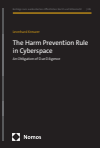Zusammenfassung
Die völkergewohnheitsrechtliche Schadenvermeidungspflicht – einschließlich ihrer Due Diligence-Anforderungen – wird in jüngster Zeit als potentiell wirkungsvolles völkerrechtliches Instrument zur Stabilisierung des Cyberspace gegen schädliche Cyberoperationen gehandelt. Bisher sind die völkergewohnheitsrechtliche Anerkennung, sowie der Inhalt und die konkrete Anwendung der Pflicht noch nicht hinreichend praxistauglich konturiert. Um diesem Problem zu begegnen, unternimmt das Buch die erste umfassende Untersuchung der Schadenvermeidungspflicht im Cyberspace. Es zeigt auf, unter welchen Voraussetzungen staatliche Due Diligence-Verpflichtungen zur Schadensvermeidung ausgelöst werden und welche Maßnahmen Staaten konkret ergreifen müssen.
Abstract
The harm prevention rule - including the due diligence standard of conduct it requires - is often seen as a potentially powerful accountability mechanism for malicious cyber operations of state and non-state actors when attribution fails. Yet a lack of clarity on its doctrinal status, content and scope has hampered its practical utility so far. To address this problem, the book provides the first comprehensive analysis of the harm prevention rule in cyberspace. Through an in-depth analysis of state practice and opinio iuris it carves out which risks of cyber harm trigger due diligence obligations to prevent harm and which measures states are required to take in concreto. The book differentiates between binding minimum standards and non-binding best practice standards.
Schlagworte
accountability mechanism Cybergefahren cyber operations Cyberoperationen cyber threats Cyberspace cyberspace Due Dilligence Mindeststandards due diligence obligations duty of care nicht-staatliche Akteure Praxisstandards harm prevention rule minimum standards Schadensprävention Schadensvermeidung non-state actors standards of practice Sorgfaltspflicht staatliche Akteure state actors Verantwortungsmechanismus- 21–26 Introduction 21–26
- 307–324 Bibliography 307–324
- 325–327 Table of Cases 325–327

